Barcelona and Galicia
We are on a train to Madrid from Barcelona. The train is speeding at 285 km per hour, and Tim has hooked my iPad to a keyboard. There's no excuse for me not to write about what we have done in the past two days.
Well, our flight from Toronto to Barcelona was uneventful and so was our clearing immigration and customs at Barcelona. The passport-checking official seemed bored and mechanically stamped our passports after a brief look at our faces and a quick glance at our photos in our passports. We were one of the last passengers from our flight to clear the passport check because we had ducked into a washroom on our way from the plane to the long line up. Our checked in luggage was waiting for us on the luggage carousel all alone as all other passengers from our plane had already picked up their bags and gone. No matter. We collected our bag and made our way to the airport shuttle which took us to the airport subway train station. Our adventure in Spain was about to begin. Imagine heavy music here.
The train has picked up speed and is whizzing past at 298 km! I am able to type at this speed, which is wonderful. Our memories are as fleeting as the scenery that we are riding past, so it is important to write for the sake of posterity. Apparently, forgetting is the norm for human beings and remembering is the exception. We tend to forget many things because that is how we are designed, or so I learned in one of the lessons I taught last term.
Everything seemed to be working fine after we landed in Barcelona. We picked up our public transport pass (unlimited for three days), got the shuttle bus to the subway station, and took the subway into the town. The station was Sants Estacio. Then things started going wrong and led to an unnecessary long walk in the midday heat to our hotel. In the end, we realized that Tim, who made all the arrangements for the trip, should have done his homework on how to get to the hotel. With Google maps and subway routes of Barcelona available on the Internet, he could have found the line that would have taken us to our hotel, and we would have emerged a few doors from our hotel.
Would have. Instead ... Dreadful music here please.
Each of us lugged one suitcase and carried one backpack as we walked a few kilometres in the heat. Maybe we can figure out later how long we walked. It was from Sants Estacio to Universidad. At Universidad, we took the subway to our destination, Plaza de Catalunya. This is the subway which we should have taken at Sants Estacio! Not only that, we would have made a bit more use of the three day unlimited pass!!
Now that I have written this, we will not forget it. The power of writing has enabled us to remember. Hurray! Now the power of the Internet can take this further and spread this information so that it can be remembered forever by web crawlers and Google searches. Well, maybe we will not put this story on our website, so Tim can be spared living in infamy.
When we travel on long trips, we should try to figure out the routes, the cost of tickets, meals, hotels, etc., or we might pay the price. We should also figure out the transit times between trains, which is the second infamous story of this trip. I am getting ahead of myself. Let me fill you in on more pleasant things we did before the second near-disaster. Hang in there!
Back to the long walk in the midday sun. We checked in at about 3 PM local time and collapsed out of sheer exhaustion. Not a big deal but a lesson to all future travellers. This is not meant to slag Tim because many arrangements have worked perfectly so far. Well, all except two so far.
When we woke up, it was around 5 PM. We showered and went out to get a few things for dinner. In an earlier trip to Europe, we had discovered that prepared foods, great bread, salads, and fruits are easy to get in Europe. This is a land of small shops! We did not have to walk far before we found so much! See the pictures of the food we found. We got back to our hotel and had a wonderful meal of bread, sausage, cheese, and fruit.

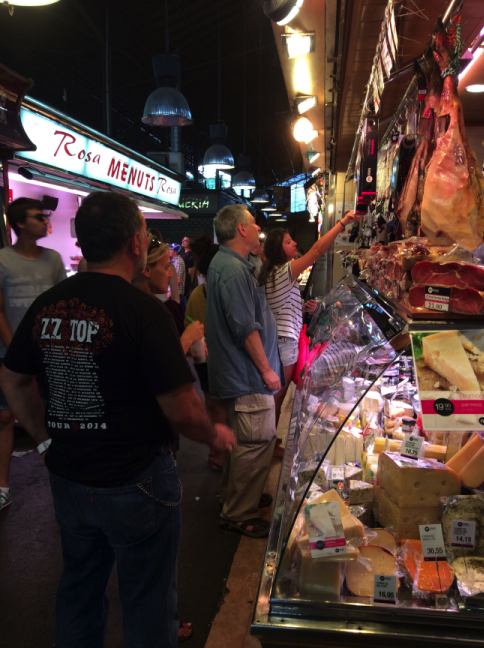
The next day, we took a couple of tourist buses to look at Barcelona. The trip was somewhat uncharacteristic for us. We hate being tourists. We hate joining hordes of crowds with binoculars, cameras, and selfie-taking extensible rods. But there was no way out. I wanted to see a couple of buildings I had read about and wasn't keen on walking. Anyway, the bus tours were really good despite our having to join lines. Here are a few pictures of Sagrada Familia.
Back to the present. Our train journey today is from Barcelona to Santiago De Compostela. We got up at 5 AM, checked out of our hotel, took the subway at our door and went to Sants Estacio and caught the train to Madrid. look at the posh breakfast they gave us to eat while traveling at 300 km/h:
In Madrid, we had to transfer to another train at a different station. This was the second infamous incident. The time for transfer was barely enough because we had to ride a subway train from one station to another. This meant figuring out where the subway station was, how to buy tickets, which platform to go to when we got there. As it turns out, we got to the second station 10 minutes before our train departure. Remember that language is an issue, so we spent time figuring out the platform number etc., and barely got onto the train in time. Again, better planning could have put us in the next train. Or, there could have been less attitude on T's part re filling in which trains we were taking that day. we could have taken a regular train direct to Chamartin, but it wasn't written down in our log, hence the subway.
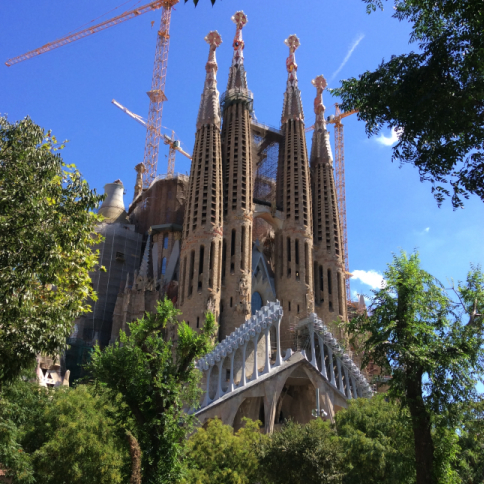

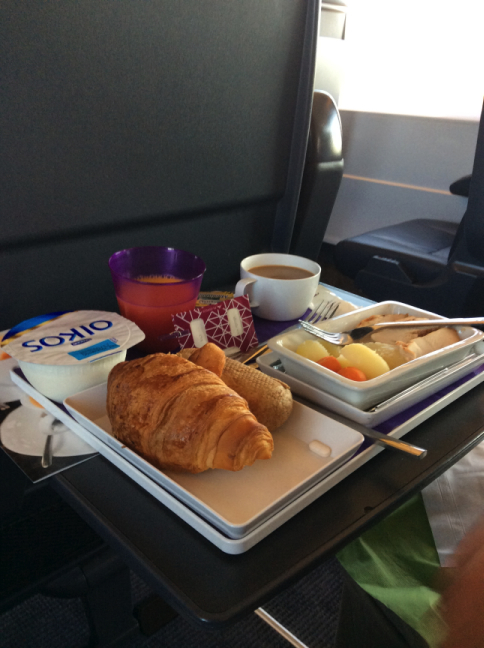
We reached Santiago de Compostela mid afternoon, after yet one more transfer. We were late for the second transfer as well, but this time, it was the train's fault, a relatively rare occurrence in Europe. Our train stopped dead in its tracks for some reason. Of course, the ticket collector phoned ahead and asked the connecting trains to wait for passengers on our train.
I had heard about the Camino de Santiago [TAD: in French known as the Milky Way, i.e. 'La voie lactee,' and hence the title of the movie by Bunuel] or the pilgrimage route people take to reach a place in Spain. Little did I know that our hotel is next to the destination. As we walked to our hotel, it seemed like we were a part of a crowd, walking determinedly in the same direction. Then we saw the destination. One of my colleagues had taken the Camino after she retired and had told us about her trip. It's a bit like a yatra that Indians take to Varanasi or a walk up the hill of lord Venkateshwara. Except, this pilgrimage takes different routes, and people get their pilgrimage passports stamped at different places along the way. I guess the pilgrims are as happy as children are upon getting stickers from their teachers for good behaviour or good marks.
People in this town are mostly tourists of one kind or another. The town's economy runs on tourism and auto industries. It is an absolutely beautiful town with hills and lovely gardens.
I should try to keep my snickering to a minimum or avoid making jokes because I certainly don't like offending people. But, between Tim and me, we joked a lot about pilgrimages. Tomorrow we meet our friends, who are professors here at University of Santiago at Lugo. They will take us around and I promise to be as polite as possible.
Will take pictures and continue this travelogue. Seems like there is wifi in this hotel, so I will try to send this off now.
The pictures above are from different parts of the Santiago de Compostela cathedral precincts. Note, behind the church, the presence of the police...
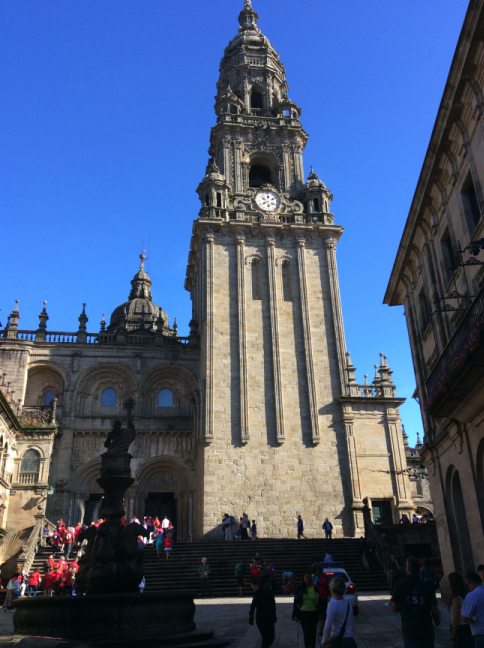
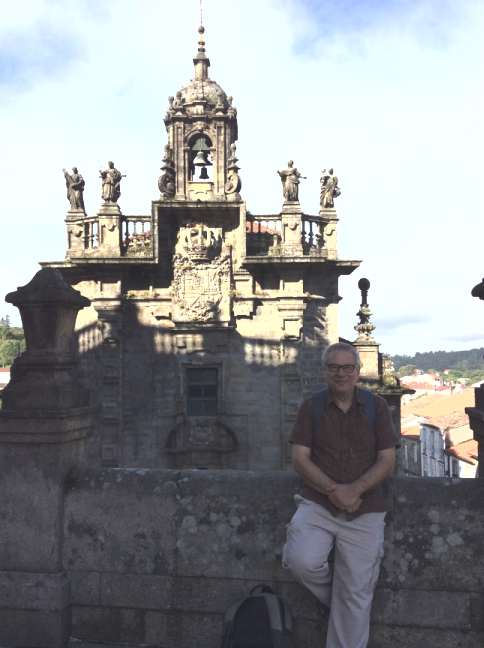
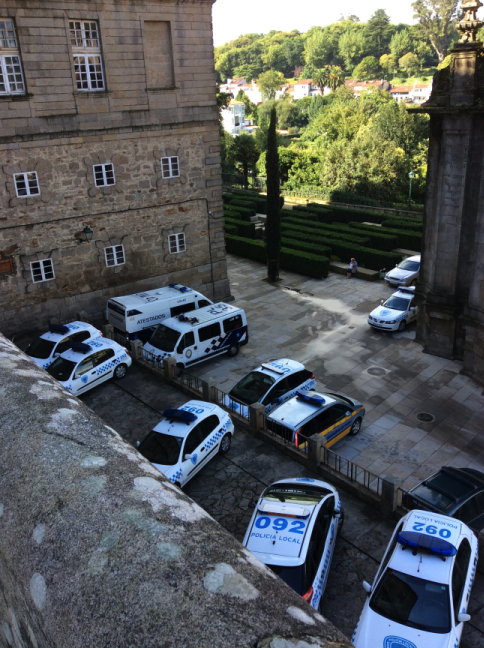

August 30
After meeting up with them in front of the cathedral, we toured around yesterday in our friends' car and got to know the surrounding countryside. Europe is full of places with historical significance and cathedrals. It might seem a bit of a drag, visiting cathedral after cathedral. In my first visit to Germany, I would often say to myself "god, let it not be another cathedral" when our hosts would offer to take us to something very interesting. Religion is big here, so I am resigned to the fact that we will visit a lot of cathedrals and must show some interest. There's always new things to learn. In our trip into the countryside yesterday, we saw many vineyards, a winery, and, of course several small churches. Some small churches seemed abandoned, and most had a small graveyard attached. This is where we saw something interesting. Engravings on some graves show several names and burial dates. It turns out that people here bury one body upon another although there are rules regarding the time period between burials; 10 years? I didn't really want to take pictures of tombstones, but learned that people can bury more than one person in one grave.
Question: Would you like to be buried with your relatives and friends? Yikes. Would you scream "I am dying to be left alone"? Ha ha.
Tim and I just made a will, two wills actually. We specifically asked to be cremated and not be embalmed. Embalmed? What is that?
When I first came to Canada, I learned about how people in North America process their dead. I worked as a laboratory technician for a doctor researching Alzheirmer's disease. People donated their brains for research, so our lab collected the brains and studied them. Naturally, I learned about the last rites after the body leaves the autopsy rooms. Then, we attended one burial (one of Tim's aunts), where I learned more stuff. My father-in-law then suggested some books I should read called "The Loved One" and "The American Way of Death." Very gory. Anyway, death is a big business in USA and Canada.
I'll write about the business of death, funeral homes, funeral directors, visitations, showings, etc. another time.
Right now, I am asking Tim to attach pictures of small churches, graveyards, and other scenes from our visit yesterday and our walk today and e-mail this part to you all.Some of you have already heard the stories on whatsapp and/or Google Hangout, but this one is for those who use e-mail only.
Until, later, enjoy the pictures (which are just about the only ones we took, en route lunch, and after finishing said lunch.




| home | Barcelona | Galicia and Paris | Köln and Hattingen | Wien | travel to Copenhagen, Gothenburg, and Oslo | Bergen | Dublin | Cambridge | London | home | Adam | John |